(All information courtesy of the instrument teams.)
![]() Previous IAU Circulars
Previous IAU Circulars
TITLE: GCN/FERMI NOTICE
NOTICE_DATE: Fri 02 Jan 09 02:55:46 UT
NOTICE_TYPE: Fermi-GBM Flight Position
RECORD_NUM: 45
TRIGGER_NUM: 252557732
GRB_RA: 122.850d {+08h 11m 24s} (J2000),
122.986d {+08h 11m 57s} (current),
122.092d {+08h 08m 22s} (1950)
GRB_DEC: +26.417d {+26d 24' 60"} (J2000),
+26.389d {+26d 23' 22"} (current),
+26.566d {+26d 33' 58"} (1950)
GRB_ERROR: 9.53 [deg radius, statistical plus systematic]
GRB_INTEN: 261 [cnts/sec]
DATA_SIGNIF: 12.00 [sigma]
INTEG_TIME: 1.024 [sec]
GRB_DATE: 14833 TJD; 2 DOY; 09/01/02
GRB_TIME: 10530.85 SOD {02:55:30.85} UT
GRB_PHI: 167.00 [deg]
GRB_THETA: 85.00 [deg]
DATA_TIME_SCALE: 1.0240 [sec]
HARD_RATIO: 0.45
LOC_ALGORITHM: 3 (version number of)
MOST_LIKELY: 92% GRB
2nd_MOST_LIKELY: 5% Generic Transient
DETECTORS: 0,0,0, 0,0,0, 0,0,0, 0,1,1, 0,0,
SUN_POSTN: 282.87d {+18h 51m 29s} -22.91d {-22d 54' 36"}
SUN_DIST: 161.41 [deg] Sun_angle= 10.7 [hr] (West of Sun)
MOON_POSTN: 343.78d {+22h 55m 06s} -3.64d {-03d 38' 38"}
MOON_DIST: 134.84 [deg]
MOON_ILLUM: 27 [%]
GAL_COORDS: 195.99, 28.38 [deg] galactic lon,lat of the burst (or transient)
ECL_COORDS: 119.26, 6.25 [deg] ecliptic lon,lat of the burst (or transient)
COMMENTS: Fermi-GBM Flight-calculated Coordinates.
COMMENTS: This trigger occurred at longitude,latitude = 59.62,0.48 [deg].
TITLE: GCN/FERMI NOTICE
NOTICE_DATE: Fri 02 Jan 09 02:56:04 UT
NOTICE_TYPE: Fermi-GBM Flight Position
RECORD_NUM: 69
TRIGGER_NUM: 252557732
GRB_RA: 133.633d {+08h 54m 32s} (J2000),
133.768d {+08h 55m 04s} (current),
132.882d {+08h 51m 32s} (1950)
GRB_DEC: +28.617d {+28d 36' 60"} (J2000),
+28.582d {+28d 34' 55"} (current),
+28.807d {+28d 48' 27"} (1950)
GRB_ERROR: 5.23 [deg radius, statistical plus systematic]
GRB_INTEN: 732 [cnts/sec]
DATA_SIGNIF: 69.10 [sigma]
INTEG_TIME: 4.096 [sec]
GRB_DATE: 14833 TJD; 2 DOY; 09/01/02
GRB_TIME: 10530.85 SOD {02:55:30.85} UT
GRB_PHI: 159.00 [deg]
GRB_THETA: 80.00 [deg]
DATA_TIME_SCALE: 4.0960 [sec]
HARD_RATIO: 0.43
LOC_ALGORITHM: 3 (version number of)
MOST_LIKELY: 94% GRB
2nd_MOST_LIKELY: 5% Generic Transient
DETECTORS: 0,0,0, 0,0,0, 0,0,0, 0,1,1, 0,0,
SUN_POSTN: 282.87d {+18h 51m 29s} -22.91d {-22d 54' 36"}
SUN_DIST: 151.68 [deg] Sun_angle= 9.9 [hr] (West of Sun)
MOON_POSTN: 343.78d {+22h 55m 07s} -3.64d {-03d 38' 33"}
MOON_DIST: 142.12 [deg]
MOON_ILLUM: 27 [%]
GAL_COORDS: 196.57, 38.18 [deg] galactic lon,lat of the burst (or transient)
ECL_COORDS: 128.07, 10.76 [deg] ecliptic lon,lat of the burst (or transient)
COMMENTS: Fermi-GBM Flight-calculated Coordinates.
COMMENTS: This trigger occurred at longitude,latitude = 59.62,0.48 [deg].
TITLE: GCN/FERMI NOTICE
NOTICE_DATE: Fri 02 Jan 09 02:55:58 UT
NOTICE_TYPE: Fermi-GBM Flight Position
RECORD_NUM: 58
TRIGGER_NUM: 252557732
GRB_RA: 133.283d {+08h 53m 08s} (J2000),
133.419d {+08h 53m 41s} (current),
132.530d {+08h 50m 07s} (1950)
GRB_DEC: +28.900d {+28d 53' 60"} (J2000),
+28.866d {+28d 51' 56"} (current),
+29.090d {+29d 05' 22"} (1950)
GRB_ERROR: 5.45 [deg radius, statistical plus systematic]
GRB_INTEN: 608 [cnts/sec]
DATA_SIGNIF: 56.90 [sigma]
INTEG_TIME: 4.096 [sec]
GRB_DATE: 14833 TJD; 2 DOY; 09/01/02
GRB_TIME: 10530.85 SOD {02:55:30.85} UT
GRB_PHI: 159.00 [deg]
GRB_THETA: 80.00 [deg]
DATA_TIME_SCALE: 4.0960 [sec]
HARD_RATIO: 0.44
LOC_ALGORITHM: 3 (version number of)
MOST_LIKELY: 94% GRB
2nd_MOST_LIKELY: 5% Generic Transient
DETECTORS: 0,0,0, 0,0,0, 0,0,0, 0,1,1, 0,0,
SUN_POSTN: 282.87d {+18h 51m 29s} -22.91d {-22d 54' 36"}
SUN_DIST: 151.96 [deg] Sun_angle= 10.0 [hr] (West of Sun)
MOON_POSTN: 343.78d {+22h 55m 07s} -3.64d {-03d 38' 35"}
MOON_DIST: 141.70 [deg]
MOON_ILLUM: 27 [%]
GAL_COORDS: 196.13, 37.95 [deg] galactic lon,lat of the burst (or transient)
ECL_COORDS: 127.69, 10.95 [deg] ecliptic lon,lat of the burst (or transient)
COMMENTS: Fermi-GBM Flight-calculated Coordinates.
COMMENTS: This trigger occurred at longitude,latitude = 59.62,0.48 [deg].
TITLE: GCN/FERMI NOTICE
NOTICE_DATE: Fri 02 Jan 09 02:56:46 UT
NOTICE_TYPE: Fermi-GBM Ground Position
RECORD_NUM: 57
TRIGGER_NUM: 252557732
GRB_RA: 120.280d {+08h 01m 07s} (J2000),
120.424d {+08h 01m 42s} (current),
119.481d {+07h 57m 56s} (1950)
GRB_DEC: +33.170d {+33d 10' 12"} (J2000),
+33.145d {+33d 08' 41"} (current),
+33.309d {+33d 18' 31"} (1950)
GRB_ERROR: 4.70 [deg radius, statistical only]
DATA_SIGNIF: 25.00 [sigma]
DATA_INTERVAL: 2.048 [sec]
GRB_DATE: 14833 TJD; 2 DOY; 09/01/02
GRB_TIME: 10530.85 SOD {02:55:30.85} UT
GRB_PHI: 163.00 [deg]
GRB_THETA: 91.00 [deg]
E_RANGE: 44.032 - 279.965 [keV]
LOC_ALGORITHM: 1 (Gnd S/W Version number)
SUN_POSTN: 282.87d {+18h 51m 29s} -22.91d {-22d 54' 35"}
SUN_DIST: 161.47 [deg] Sun_angle= 10.8 [hr] (West of Sun)
MOON_POSTN: 343.78d {+22h 55m 08s} -3.64d {-03d 38' 23"}
MOON_DIST: 129.96 [deg]
MOON_ILLUM: 27 [%]
GAL_COORDS: 187.92, 28.20 [deg] galactic lon,lat of the burst (or transient)
ECL_COORDS: 115.60, 12.38 [deg] ecliptic lon,lat of the burst (or transient)
COMMENTS: Fermi-GBM Ground-calculated Coordinates.
COMMENTS: This Notice was ground-generated -- not flight-generated.
TITLE: GCN/SWIFT NOTICE
NOTICE_DATE: Fri 02 Jan 09 02:56:20 UT
NOTICE_TYPE: Swift-BAT GRB Position
TRIGGER_NUM: 338895, Seg_Num: 0
GRB_RA: 128.259d {+08h 33m 02s} (J2000),
128.400d {+08h 33m 36s} (current),
127.475d {+08h 29m 54s} (1950)
GRB_DEC: +33.092d {+33d 05' 29"} (J2000),
+33.060d {+33d 03' 37"} (current),
+33.262d {+33d 15' 45"} (1950)
GRB_ERROR: 3.00 [arcmin radius, statistical only]
GRB_INTEN: 13729 [cnts] Image_Peak=239 [image_cnts]
TRIGGER_DUR: 2.048 [sec]
TRIGGER_INDEX: 271 E_range: 50-350 keV
BKG_INTEN: 78032 [cnts]
BKG_TIME: 10508.61 SOD {02:55:08.61} UT
BKG_DUR: 24 [sec]
GRB_DATE: 14833 TJD; 2 DOY; 09/01/02
GRB_TIME: 10545.86 SOD {02:55:45.86} UT
GRB_PHI: 46.15 [deg]
GRB_THETA: 45.23 [deg]
SOLN_STATUS: 0x3
RATE_SIGNIF: 77.51 [sigma]
IMAGE_SIGNIF: 9.37 [sigma]
MERIT_PARAMS: +1 +0 +0 +2 +3 +22 +0 +0 +91 +0
SUN_POSTN: 282.87d {+18h 51m 29s} -22.91d {-22d 54' 36"}
SUN_DIST: 155.36 [deg] Sun_angle= 10.3 [hr] (West of Sun)
MOON_POSTN: 343.78d {+22h 55m 08s} -3.64d {-03d 38' 30"}
MOON_DIST: 135.77 [deg]
MOON_ILLUM: 27 [%]
GAL_COORDS: 189.88, 34.67 [deg] galactic lon,lat of the burst (or transient)
ECL_COORDS: 122.30, 13.84 [deg] ecliptic lon,lat of the burst (or transient)
COMMENTS: SWIFT-BAT GRB Coordinates.
COMMENTS: This is a rate trigger.
COMMENTS: A point_source was found.
COMMENTS: This does not match any source in the on-board catalog.
COMMENTS: This does not match any source in the ground catalog.
COMMENTS: This is a GRB.
COMMENTS: This trigger occurred at longitude,latitude = 229.23,18.89 [deg].
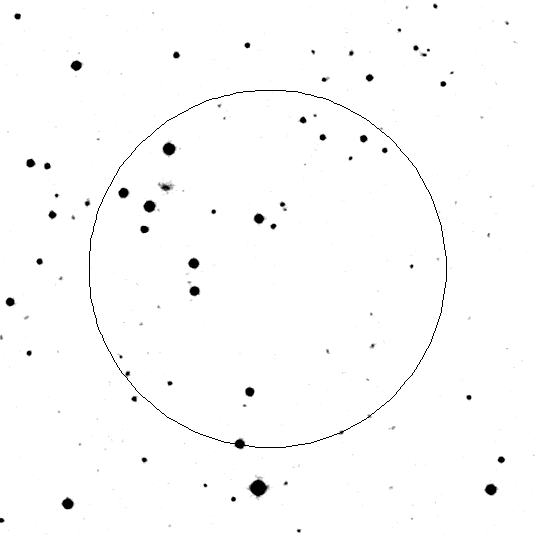
TITLE: GCN/FERMI NOTICE
NOTICE_DATE: Fri 02 Jan 09 02:56:53 UT
NOTICE_TYPE: Fermi-GBM Ground Position
RECORD_NUM: 71
TRIGGER_NUM: 252557732
GRB_RA: 130.860d {+08h 43m 26s} (J2000),
131.003d {+08h 44m 01s} (current),
130.063d {+08h 40m 15s} (1950)
GRB_DEC: +36.330d {+36d 19' 48"} (J2000),
+36.297d {+36d 17' 50"} (current),
+36.511d {+36d 30' 38"} (1950)
GRB_ERROR: 1.21 [deg radius, statistical only]
DATA_SIGNIF: 79.60 [sigma]
DATA_INTERVAL: 4.096 [sec]
GRB_DATE: 14833 TJD; 2 DOY; 09/01/02
GRB_TIME: 10530.85 SOD {02:55:30.85} UT
GRB_PHI: 155.00 [deg]
GRB_THETA: 87.00 [deg]
E_RANGE: 44.032 - 279.965 [keV]
LOC_ALGORITHM: 1 (Gnd S/W Version number)
SUN_POSTN: 282.87d {+18h 51m 29s} -22.91d {-22d 54' 35"}
SUN_DIST: 152.27 [deg] Sun_angle= 10.1 [hr] (West of Sun)
MOON_POSTN: 343.79d {+22h 55m 09s} -3.64d {-03d 38' 22"}
MOON_DIST: 135.55 [deg]
MOON_ILLUM: 27 [%]
GAL_COORDS: 186.42, 37.36 [deg] galactic lon,lat of the burst (or transient)
ECL_COORDS: 123.55, 17.53 [deg] ecliptic lon,lat of the burst (or transient)
COMMENTS: Fermi-GBM Ground-calculated Coordinates.
COMMENTS: This Notice was ground-generated -- not flight-generated.
TITLE: GCN/SWIFT NOTICE
NOTICE_DATE: Fri 02 Jan 09 02:59:18 UT
NOTICE_TYPE: Swift-BAT GRB Lightcurve
TRIGGER_NUM: 338895, Seg_Num: 0
GRB_RA: 128.259d {+08h 33m 02s} (J2000),
128.400d {+08h 33m 36s} (current),
127.475d {+08h 29m 54s} (1950)
GRB_DEC: +33.092d {+33d 05' 29"} (J2000),
+33.060d {+33d 03' 37"} (current),
+33.262d {+33d 15' 45"} (1950)
GRB_DATE: 14833 TJD; 2 DOY; 09/01/02
GRB_TIME: 10545.86 SOD {02:55:45.86} UT
TRIGGER_INDEX: 271
GRB_PHI: 46.15 [deg]
GRB_THETA: 45.23 [deg]
DELTA_TIME: -44.00 [sec]
TRIGGER_DUR: 2.048 [sec]
SOLN_STATUS: 0x3
RATE_SIGNIF: 77.51 [sigma]
IMAGE_SIGNIF: 9.37 [sigma]
LC_URL: sw00338895000msb.lc
SUN_POSTN: 282.87d {+18h 51m 30s} -22.91d {-22d 54' 35"}
SUN_DIST: 155.37 [deg] Sun_angle= 10.3 [hr] (West of Sun)
MOON_POSTN: 343.80d {+22h 55m 13s} -3.63d {-03d 37' 48"}
MOON_DIST: 135.75 [deg]
MOON_ILLUM: 27 [%]
GAL_COORDS: 189.88, 34.67 [deg] galactic lon,lat of the burst (or transient)
ECL_COORDS: 122.30, 13.84 [deg] ecliptic lon,lat of the burst (or transient)
COMMENTS: SWIFT-BAT GRB Lightcurve.
COMMENTS:
COMMENTS: The next comments were copied from the BAT_POS Notice:
COMMENTS: This is a rate trigger.
COMMENTS: A point_source was found.
COMMENTS: This does not match any source in the on-board catalog.
COMMENTS: This does not match any source in the ground catalog.
COMMENTS: This is a GRB.
COMMENTS: This trigger occurred at longitude,latitude = 229.23,18.89 [deg].
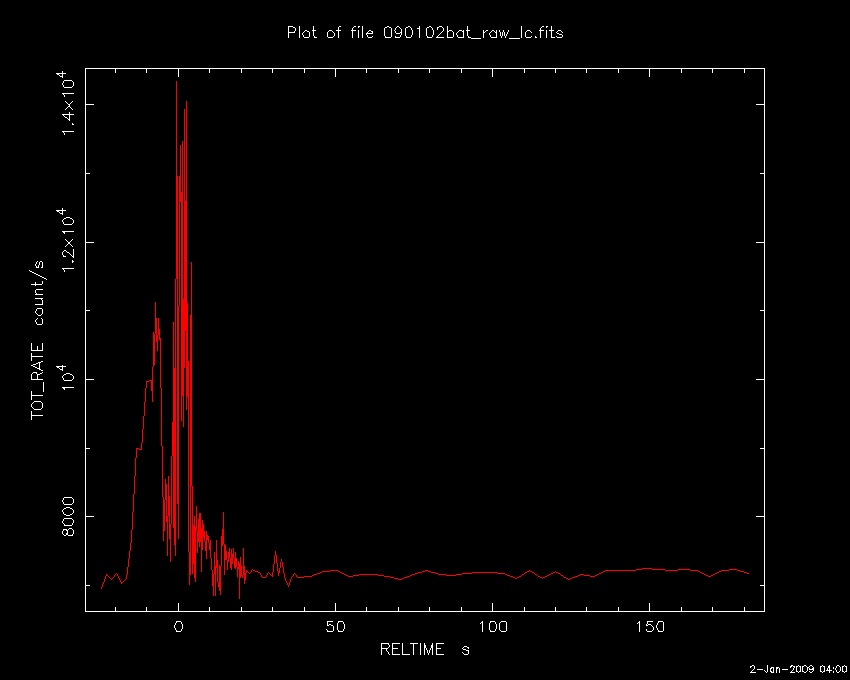
TITLE: GCN/SWIFT NOTICE
NOTICE_DATE: Fri 02 Jan 09 03:02:48 UT
NOTICE_TYPE: Swift-XRT Position
TRIGGER_NUM: 338895, Seg_Num: 0
GRB_RA: 128.2423d {+08h 32m 58.15s} (J2000),
128.3833d {+08h 33m 31.99s} (current),
127.4579d {+08h 29m 49.90s} (1950)
GRB_DEC: +33.1142d {+33d 06' 51.1"} (J2000),
+33.0831d {+33d 04' 59.2"} (current),
+33.2850d {+33d 17' 06.1"} (1950)
GRB_ERROR: 6.1 [arcsec radius, statistical plus systematic, 90% containment]
GRB_INTEN: 6.09e-10 [erg/cm2/sec]
GRB_SIGNIF: 5.09 [sigma]
IMG_START_DATE: 14833 TJD; 2 DOY; 09/01/02
IMG_START_TIME: 10933.07 SOD {03:02:13.07} UT, 387.2 [sec] since BAT Trigger Time
TAM[0-3]: 327.65 237.23 261.56 243.39
AMPLIFIER: 2
WAVEFORM: 134
SUN_POSTN: 282.88d {+18h 51m 30s} -22.91d {-22d 54' 34"}
SUN_DIST: 155.37 [deg] Sun_angle= 10.3 [hr] (West of Sun)
MOON_POSTN: 343.83d {+22h 55m 20s} -3.62d {-03d 36' 58"}
MOON_DIST: 135.70 [deg]
MOON_ILLUM: 27 [%]
GAL_COORDS: 189.85, 34.66 [deg] galactic lon,lat of the burst
ECL_COORDS: 122.28, 13.86 [deg] ecliptic lon,lat of the burst
COMMENTS: SWIFT-XRT Coordinates.
COMMENTS: The XRT position is 1.60 arcmin from the BAT position.
TITLE: GCN/SWIFT NOTICE
NOTICE_DATE: Fri 02 Jan 09 03:03:03 UT
NOTICE_TYPE: Swift-XRT Image
TRIGGER_NUM: 338895, Seg_Num: 0
GRB_RA: 128.2423d {+08h 32m 58.1s} (J2000),
128.3833d {+08h 33m 31.9s} (current),
127.4579d {+08h 29m 49.9s} (1950)
GRB_DEC: +33.1142d {+33d 06' 51.1"} (J2000),
+33.0831d {+33d 04' 59.2"} (current),
+33.2850d {+33d 17' 06.1"} (1950)
GRB_ERROR: 6.1 [arcsec, radius, statistical plus systematic]
GRB_INTEN: 26 [cnts]
IMG_START_DATE: 14833 TJD; 2 DOY; 09/01/02
IMG_START_TIME: 10933.07 SOD {03:02:13.07} UT, 387.2 [sec] since BAT Trigger Time
CENTROID_X: 309.72, raw= 310 [pixels]
CENTROID_Y: 352.61, raw= 353 [pixels]
ROLL: 72.02 [deg]
GAIN: 1
MODE: 3, Long Image mode
WAVEFORM: 134
EXPO_TIME: 2.50 [sec]
GRB_POS_XRT_Y: 128.73
GRB_POS_XRT_Z: 17.50
IMAGE_URL: sw00338895000msxps_rw.img
SUN_POSTN: 282.88d {+18h 51m 30s} -22.91d {-22d 54' 34"}
SUN_DIST: 155.37 [deg] Sun_angle= 10.3 [hr] (West of Sun)
MOON_POSTN: 343.83d {+22h 55m 20s} -3.62d {-03d 36' 54"}
MOON_DIST: 135.69 [deg]
MOON_ILLUM: 27 [%]
GAL_COORDS: 189.85, 34.66 [deg] galactic lon,lat of the burst
ECL_COORDS: 122.28, 13.86 [deg] ecliptic lon,lat of the burst
COMMENTS: SWIFT-XRT Image.

TITLE: GCN/SWIFT NOTICE
NOTICE_DATE: Fri 02 Jan 09 03:03:05 UT
NOTICE_TYPE: Swift-XRT Processed Image
TRIGGER_NUM: 338895, Seg_Num: 0
GRB_RA: 128.2423d {+08h 32m 58.1s} (J2000),
128.3833d {+08h 33m 31.9s} (current),
127.4579d {+08h 29m 49.9s} (1950)
GRB_DEC: +33.1142d {+33d 06' 51.1"} (J2000),
+33.0831d {+33d 04' 59.2"} (current),
+33.2850d {+33d 17' 06.1"} (1950)
GRB_ERROR: 6.1 [arcsec, radius, statistical plus systematic]
GRB_INTEN: 26 [cnts]
IMG_START_DATE: 14833 TJD; 2 DOY; 09/01/02
IMG_START_TIME: 10933.07 SOD {03:02:13.07} UT, 387.2 [sec] since BAT Trigger Time
CENTROID_X: 309.72, raw= 310 [pixels]
CENTROID_Y: 352.61, raw= 353 [pixels]
ROLL: 72.02 [deg]
GAIN: 1
MODE: 3, Long Image mode
WAVEFORM: 134
EXPO_TIME: 2.50 [sec]
GRB_POS_XRT_Y: 128.73
GRB_POS_XRT_Z: 17.50
IMAGE_URL: sw00338895000msxps_rw.img
SUN_POSTN: 282.88d {+18h 51m 30s} -22.91d {-22d 54' 34"}
SUN_DIST: 155.37 [deg] Sun_angle= 10.3 [hr] (West of Sun)
MOON_POSTN: 343.83d {+22h 55m 20s} -3.62d {-03d 36' 54"}
MOON_DIST: 135.69 [deg]
MOON_ILLUM: 27 [%]
GAL_COORDS: 189.85, 34.66 [deg] galactic lon,lat of the burst
ECL_COORDS: 122.28, 13.86 [deg] ecliptic lon,lat of the burst
COMMENTS: SWIFT-XRT Processed Image.

TITLE: GCN/SWIFT NOTICE
NOTICE_DATE: Fri 02 Jan 09 03:05:09 UT
NOTICE_TYPE: Swift-UVOT Source List
TRIGGER_NUM: 338895, Seg_Num: 0
POINT_RA: 128.261d {+08h 33m 03s} (J2000)
POINT_DEC: +33.081d {+33d 04' 53"} (J2000)
POINT_ROLL: 72.018d
IMG_START_DATE: 14833 TJD; 2 DOY; 09/01/02
IMG_START_TIME: 10941.33 SOD {03:02:21.33} UT, 395.5 [sec] since BAT Trigger Time
FILTER: 10, White
BKG_MEAN: 2.799
N_STARS: 26
X_OFFSET: 456 [pixels]
Y_OFFSET: 496 [pixels]
X_MAX: 1415 [pixels]
Y_MAX: 1455 [pixels]
DET_THRESH: 14
PHOTO_THRESH: 7
SL_URL: sw00338895000msufc0395.fits
SUN_POSTN: 282.88d {+18h 51m 31s} -22.91d {-22d 54' 34"}
SUN_DIST: 155.37 [deg] Sun_angle= 10.3 [hr] (West of Sun)
MOON_POSTN: 343.85d {+22h 55m 24s} -3.61d {-03d 36' 25"}
MOON_DIST: 135.71 [deg]
MOON_ILLUM: 27 [%]
GAL_COORDS: 189.89, 34.66 [deg] galactic lon,lat of the pointing direction
ECL_COORDS: 122.30, 13.83 [deg] ecliptic lon,lat of the pointing direction
COMMENTS: SWIFT-UVOT Source List.
TITLE: GCN/SWIFT NOTICE
NOTICE_DATE: Fri 02 Jan 09 03:05:41 UT
NOTICE_TYPE: Swift-UVOT Processed Source List
TRIGGER_NUM: 338895, Seg_Num: 0
POINT_RA: 128.261d {+08h 33m 03s} (J2000)
POINT_DEC: +33.081d {+33d 04' 53"} (J2000)
POINT_ROLL: 72.018d
IMG_START_DATE: 14833 TJD; 2 DOY; 09/01/02
IMG_START_TIME: 10941.33 SOD {03:02:21.33} UT, 395.5 [sec] since BAT Trigger Time
FILTER: 10, White
BKG_MEAN: 2.799
N_STARS: 26
X_OFFSET: 456 [pixels]
Y_OFFSET: 496 [pixels]
X_MAX: 1415 [pixels]
Y_MAX: 1455 [pixels]
DET_THRESH: 14
PHOTO_THRESH: 7
SL_URL: sw00338895000msufc0395.fits
SUN_POSTN: 282.88d {+18h 51m 31s} -22.91d {-22d 54' 33"}
SUN_DIST: 155.37 [deg] Sun_angle= 10.3 [hr] (West of Sun)
MOON_POSTN: 343.85d {+22h 55m 25s} -3.61d {-03d 36' 17"}
MOON_DIST: 135.70 [deg]
MOON_ILLUM: 27 [%]
GAL_COORDS: 189.89, 34.66 [deg] galactic lon,lat of the pointing direction
ECL_COORDS: 122.30, 13.83 [deg] ecliptic lon,lat of the pointing direction
COMMENTS: SWIFT-UVOT Processed Source List.
COMMENTS: All 4 attachments are included.
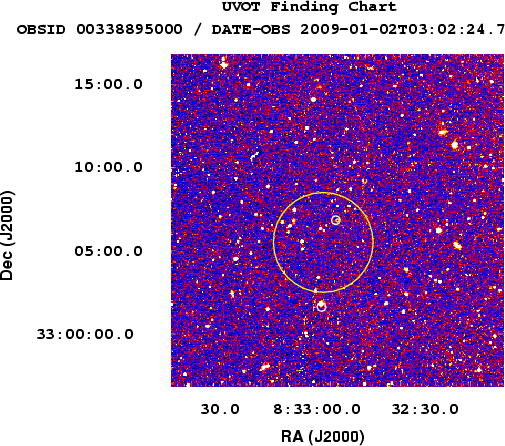
TITLE: GCN/SWIFT NOTICE
NOTICE_DATE: Fri 02 Jan 09 03:06:43 UT
NOTICE_TYPE: Swift-UVOT Image
TRIGGER_NUM: 338895, Seg_Num: 0
POINT_RA: 128.261d {+08h 33m 03s} (J2000)
POINT_DEC: +33.081d {+33d 04' 53"} (J2000)
ROLL: 72.018d
IMG_START_DATE: 14833 TJD; 2 DOY; 09/01/02
IMG_START_TIME: 10941.33 SOD {03:02:21.33} UT, 395.5 [sec] since BAT Trigger Time
FILTER: 10, White
EXPOSURE_ID: 252558144
X_OFFSET: 647 [pixels]
Y_OFFSET: 675 [pixels]
WIDTH: 160 [pixels]
HEIGHT: 160 [pixels]
X_GRB_POS: 807
Y_GRB_POS: 835
BINNING_INDEX: 1
IM_URL: sw00338895000msuni0395.fits
SUN_POSTN: 282.88d {+18h 51m 31s} -22.91d {-22d 54' 33"}
SUN_DIST: 155.37 [deg] Sun_angle= 10.3 [hr] (West of Sun)
MOON_POSTN: 343.86d {+22h 55m 27s} -3.60d {-03d 36' 02"}
MOON_DIST: 135.69 [deg]
MOON_ILLUM: 27 [%]
GAL_COORDS: 189.89, 34.66 [deg] galactic lon,lat of the pointing direction
ECL_COORDS: 122.30, 13.83 [deg] ecliptic lon,lat of the pointing direction
COMMENTS: SWIFT-UVOT Image.
COMMENTS: The GRB Position came from the XRT Position Command.
COMMENTS: The image has 2x2 binning (compression).
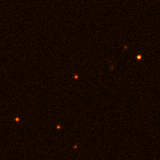
TITLE: GCN/SWIFT NOTICE
NOTICE_DATE: Fri 02 Jan 09 03:06:58 UT
NOTICE_TYPE: Swift-UVOT Processed Image
TRIGGER_NUM: 338895, Seg_Num: 0
POINT_RA: 128.261d {+08h 33m 03s} (J2000)
POINT_DEC: +33.081d {+33d 04' 53"} (J2000)
ROLL: 72.018d
IMG_START_DATE: 14833 TJD; 2 DOY; 09/01/02
IMG_START_TIME: 10941.33 SOD {03:02:21.33} UT, 395.5 [sec] since BAT Trigger Time
FILTER: 10, White
EXPOSURE_ID: 252558144
X_OFFSET: 647 [pixels]
Y_OFFSET: 675 [pixels]
WIDTH: 160 [pixels]
HEIGHT: 160 [pixels]
X_GRB_POS: 807
Y_GRB_POS: 835
BINNING_INDEX: 1
IM_URL: sw00338895000msuni0395.fits
SUN_POSTN: 282.88d {+18h 51m 31s} -22.91d {-22d 54' 33"}
SUN_DIST: 155.37 [deg] Sun_angle= 10.3 [hr] (West of Sun)
MOON_POSTN: 343.86d {+22h 55m 27s} -3.60d {-03d 35' 59"}
MOON_DIST: 135.69 [deg]
MOON_ILLUM: 27 [%]
GAL_COORDS: 189.89, 34.66 [deg] galactic lon,lat of the pointing direction
ECL_COORDS: 122.30, 13.83 [deg] ecliptic lon,lat of the pointing direction
COMMENTS: SWIFT-UVOT Processed Image.
COMMENTS: The GRB Position came from the XRT Position Command.
COMMENTS: The image has 2x2 binning (compression).
COMMENTS: If you have elected to receive attachments:
COMMENTS: The uvot_sources_image.fits.gz file does not exist; skipping the attachment.
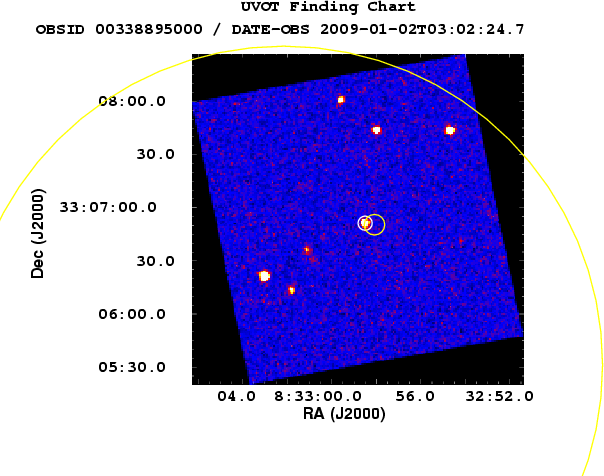
RA(J2000.0) = 08h 32m 38.1s DEC(J2000.0) +33d 11' 45.3"OT was R~15.3 at about 100s after GRB.
RA(J2000) = 08h 33m 02s Dec(J2000) = +33d 05' 29"with an uncertainty of 3 arcmin (radius, 90% containment, including systematic uncertainty). The BAT light curve showed a multi-peaked structure with a duration of about 30 sec starting about 15 sec before the trigger. The peak count rate was ~7000 counts/sec (15-350 keV), at ~2 sec after the trigger.
RA(J2000) = 08h 32m 58.15s Dec(J2000) = +33d 06' 51.1"with an uncertainty of 6.1 arcseconds (radius, 90% containment). This location is 94 arcseconds from the BAT onboard position, within the BAT error circle. No event data are yet available to determine the column density using X-ray spectroscopy.
RA(J2000) = 08:32:58.54 = 128.24391 DEC(J2000) = +33:06:51.2 = 33.11421with a 90%-confidence error radius of about 1.10 arc sec. This position is 4.8 arc sec. from the center of the XRT error circle. The estimated magnitude is 18.11. No correction has been made for the expected extinction corresponding to E(B-V) of 0.05.
TITLE: GCN/SWIFT NOTICE
NOTICE_DATE: Fri 02 Jan 09 03:10:36 UT
NOTICE_TYPE: Swift-XRT Position UPDATE
TRIGGER_NUM: 338895, Seg_Num: 0
GRB_RA: 128.2436d {+08h 32m 58.46s} (J2000),
128.3846d {+08h 33m 32.30s} (current),
127.4592d {+08h 29m 50.21s} (1950)
GRB_DEC: +33.1129d {+33d 06' 46.4"} (J2000),
+33.0818d {+33d 04' 54.5"} (current),
+33.2837d {+33d 17' 01.4"} (1950)
GRB_ERROR: 4.8 [arcsec radius, statistical plus systematic, 90% containment]
GRB_INTEN: 1.00e-10 [erg/cm2/sec]
GRB_SIGNIF: 10.00 [sigma]
IMG_START_DATE: 14833 TJD; 2 DOY; 09/01/02
IMG_START_TIME: 11183.00 SOD {03:06:23.00} UT, 637.1 [sec] since BAT Trigger Time
TAM[0-3]: 100.00 100.00 100.00 100.00
AMPLIFIER: 1
WAVEFORM: 31
SUN_POSTN: 282.88d {+18h 51m 32s} -22.91d {-22d 54' 32"}
SUN_DIST: 155.38 [deg] Sun_angle= 10.3 [hr] (West of Sun)
MOON_POSTN: 343.89d {+22h 55m 34s} -3.59d {-03d 35' 07"}
MOON_DIST: 135.63 [deg]
MOON_ILLUM: 27 [%]
GAL_COORDS: 189.85, 34.66 [deg] galactic lon,lat of the burst
ECL_COORDS: 122.28, 13.86 [deg] ecliptic lon,lat of the burst
COMMENTS: SWIFT-XRT Coordinates.
COMMENTS: This Notice was ground-generated -- not flight-generated.
COMMENTS: This is an Update Notice -- the RA,Dec values herein supersede the previous XRT_POS Notice.
COMMENTS: TAM values, flux and significance fields are not valid
COMMENTS: This position was automatically generated on the ground using
COMMENTS: Photon Counting data telemetered via TDRSS (SPER data).
COMMENTS: See http://www.swift.ac.uk/sper/docs.php for details.
TITLE: GCN/SWIFT NOTICE
NOTICE_DATE: Fri 02 Jan 09 03:15:40 UT
NOTICE_TYPE: Swift-UVOT Source List
TRIGGER_NUM: 338895, Seg_Num: 0
POINT_RA: 128.260d {+08h 33m 02s} (J2000)
POINT_DEC: +33.083d {+33d 04' 58"} (J2000)
POINT_ROLL: 72.015d
IMG_START_DATE: 14833 TJD; 2 DOY; 09/01/02
IMG_START_TIME: 11415.65 SOD {03:10:15.65} UT, 869.8 [sec] since BAT Trigger Time
FILTER: 10, White
BKG_MEAN: 2.661
N_STARS: 78
X_OFFSET: 87 [pixels]
Y_OFFSET: 115 [pixels]
X_MAX: 1526 [pixels]
Y_MAX: 1554 [pixels]
DET_THRESH: 13
PHOTO_THRESH: 7
SL_URL: sw00338895000msufc0869.fits
SUN_POSTN: 282.89d {+18h 51m 33s} -22.91d {-22d 54' 31"}
SUN_DIST: 155.38 [deg] Sun_angle= 10.3 [hr] (West of Sun)
MOON_POSTN: 343.93d {+22h 55m 44s} -3.57d {-03d 33' 55"}
MOON_DIST: 135.62 [deg]
MOON_ILLUM: 27 [%]
GAL_COORDS: 189.89, 34.66 [deg] galactic lon,lat of the pointing direction
ECL_COORDS: 122.30, 13.83 [deg] ecliptic lon,lat of the pointing direction
COMMENTS: SWIFT-UVOT Source List.
TITLE: GCN/SWIFT NOTICE
NOTICE_DATE: Fri 02 Jan 09 03:16:13 UT
NOTICE_TYPE: Swift-UVOT Processed Source List
TRIGGER_NUM: 338895, Seg_Num: 0
POINT_RA: 128.260d {+08h 33m 02s} (J2000)
POINT_DEC: +33.083d {+33d 04' 58"} (J2000)
POINT_ROLL: 72.015d
IMG_START_DATE: 14833 TJD; 2 DOY; 09/01/02
IMG_START_TIME: 11415.65 SOD {03:10:15.65} UT, 869.8 [sec] since BAT Trigger Time
FILTER: 10, White
BKG_MEAN: 2.661
N_STARS: 78
X_OFFSET: 87 [pixels]
Y_OFFSET: 115 [pixels]
X_MAX: 1526 [pixels]
Y_MAX: 1554 [pixels]
DET_THRESH: 13
PHOTO_THRESH: 7
SL_URL: sw00338895000msufc0869.fits
SUN_POSTN: 282.89d {+18h 51m 33s} -22.91d {-22d 54' 31"}
SUN_DIST: 155.38 [deg] Sun_angle= 10.3 [hr] (West of Sun)
MOON_POSTN: 343.94d {+22h 55m 45s} -3.56d {-03d 33' 48"}
MOON_DIST: 135.62 [deg]
MOON_ILLUM: 27 [%]
GAL_COORDS: 189.89, 34.66 [deg] galactic lon,lat of the pointing direction
ECL_COORDS: 122.30, 13.83 [deg] ecliptic lon,lat of the pointing direction
COMMENTS: SWIFT-UVOT Processed Source List.
COMMENTS: All 4 attachments are included.
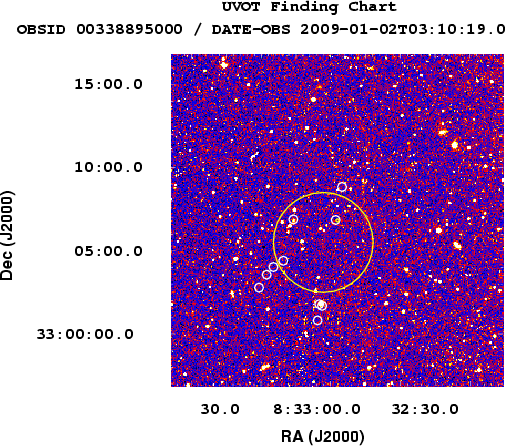
TITLE: GCN/SWIFT NOTICE
NOTICE_DATE: Fri 02 Jan 09 03:17:01 UT
NOTICE_TYPE: Swift-UVOT Image
TRIGGER_NUM: 338895, Seg_Num: 0
POINT_RA: 128.260d {+08h 33m 02s} (J2000)
POINT_DEC: +33.083d {+33d 04' 58"} (J2000)
ROLL: 72.015d
IMG_START_DATE: 14833 TJD; 2 DOY; 09/01/02
IMG_START_TIME: 11415.65 SOD {03:10:15.65} UT, 869.8 [sec] since BAT Trigger Time
FILTER: 10, White
EXPOSURE_ID: 252558619
X_OFFSET: 646 [pixels]
Y_OFFSET: 674 [pixels]
WIDTH: 160 [pixels]
HEIGHT: 160 [pixels]
X_GRB_POS: 806
Y_GRB_POS: 834
BINNING_INDEX: 1
IM_URL: sw00338895000msuni0869.fits
SUN_POSTN: 282.89d {+18h 51m 33s} -22.91d {-22d 54' 31"}
SUN_DIST: 155.38 [deg] Sun_angle= 10.3 [hr] (West of Sun)
MOON_POSTN: 343.94d {+22h 55m 46s} -3.56d {-03d 33' 36"}
MOON_DIST: 135.61 [deg]
MOON_ILLUM: 27 [%]
GAL_COORDS: 189.89, 34.66 [deg] galactic lon,lat of the pointing direction
ECL_COORDS: 122.30, 13.83 [deg] ecliptic lon,lat of the pointing direction
COMMENTS: SWIFT-UVOT Image.
COMMENTS: The GRB Position came from the Window Position in the Mode Command.
COMMENTS: The image has 2x2 binning (compression).
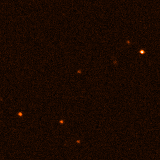
TITLE: GCN/SWIFT NOTICE
NOTICE_DATE: Fri 02 Jan 09 03:17:29 UT
NOTICE_TYPE: Swift-UVOT Processed Image
TRIGGER_NUM: 338895, Seg_Num: 0
POINT_RA: 128.260d {+08h 33m 02s} (J2000)
POINT_DEC: +33.083d {+33d 04' 58"} (J2000)
ROLL: 72.015d
IMG_START_DATE: 14833 TJD; 2 DOY; 09/01/02
IMG_START_TIME: 11415.65 SOD {03:10:15.65} UT, 869.8 [sec] since BAT Trigger Time
FILTER: 10, White
EXPOSURE_ID: 252558619
X_OFFSET: 646 [pixels]
Y_OFFSET: 674 [pixels]
WIDTH: 160 [pixels]
HEIGHT: 160 [pixels]
X_GRB_POS: 806
Y_GRB_POS: 834
BINNING_INDEX: 1
IM_URL: sw00338895000msuni0869.fits
SUN_POSTN: 282.89d {+18h 51m 33s} -22.91d {-22d 54' 31"}
SUN_DIST: 155.38 [deg] Sun_angle= 10.3 [hr] (West of Sun)
MOON_POSTN: 343.95d {+22h 55m 47s} -3.56d {-03d 33' 30"}
MOON_DIST: 135.61 [deg]
MOON_ILLUM: 27 [%]
GAL_COORDS: 189.89, 34.66 [deg] galactic lon,lat of the pointing direction
ECL_COORDS: 122.30, 13.83 [deg] ecliptic lon,lat of the pointing direction
COMMENTS: SWIFT-UVOT Processed Image.
COMMENTS: The GRB Position came from the Window Position in the Mode Command.
COMMENTS: The image has 2x2 binning (compression).
COMMENTS: If you have elected to receive attachments:
COMMENTS: The uvot_sources_image.fits.gz file does not exist; skipping the attachment.
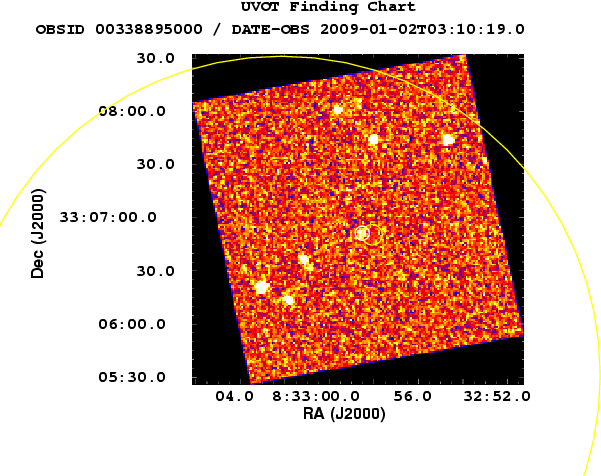
tstart tend R dR 40.8 46.8 14.3 0.2 46.8 52.8 13.6 0.1 52.8 58.8 13.4 0.1 58.8 64.8 13.4 0.1 64.8 70.8 13.5 0.1 70.8 76.8 13.7 0.1 76.8 82.8 13.7 0.1 82.8 88.8 14.0 0.1 88.8 94.8 14.1 0.1 94.8 100.8 14.3 0.1 107.6 137.6 14.4 0.2 144.6 174.6 14.9 0.2 181.6 211.6 15.5 0.3Further observations are in progress
RA (J2000): 08h 32m 58.60s Dec (J2000): +33d 06' 52.1"with an uncertainty of 1.7 arcsec (radius, 90% confidence).
RA: 08:32:58.54 Dec.: +33:06:51.1A 45-min low-resolution spectrum was also obained (2 hours post burst). A firm upper limit of z < 2.1 can be placed on the redshift of GRB 090102 from the lack of Ly-alpha forest lines in the spectrum of the afterglow.
RA(J2000) = 08h 32m 59.5s Dec(J2000) = +33d 06' 25.7"with an uncertainty of 1.4 arcmin, (radius, sys+stat, 90% containment). The partial coding was 6%.
Filter t_mid(s) Exp(s) Mag wh 470. 147. 18.04 +/- 0.04 v 382. 10. 17.02 +/- 0.29 b 660. 19. 18.35 +/- 0.27 u 635. 19. 17.89 +/- 0.26 uvw1 3547. 255. >19.99 uvm2 6278. 197. >19.67 uvw2 1035. 388. >20.45The detection in u along with the limits in uvw1 and bluer is consistent with a redshift of approximately ~1.8 < z < ~2.5 and with the spectroscopic redshift suggested by de Ugarte Postigo et al. (GCN 8766).
T_mid[s] Exp[s] AB Mag MagErr ------------------------------- 9042 66 20.58 0.05 9158 66 20.59 0.04 9265 66 20.58 0.03 9373 66 20.59 0.06 9515 115 20.59 0.04 9711 115 20.65 0.02 9903 115 20.67 0.02 10091 115 20.66 0.03 10423 375 20.70 0.02 10868 375 20.78 0.02 11320 375 20.79 0.02 11780 375 20.86 0.02The quoted error is statistical only. There is an additional systematic error in the absolute calibration using SDSS field stars which is expected to be in the 0.05 mag range.
Tmid (s) Texp (s) Mag Err -------------------------------------- 3190.2 120.0 19.75 0.13 5266.2 120.0 20.02 0.06 7704.3 120.0 20.41 0.07 9973.9 120.0 20.56 0.07 11911.5 120.0 20.78 0.08 14068.6 120.0 21.01 0.09 16144.7 120.0 21.09 0.09 18522.6 600.0 21.23 0.06 20631.5 600.0 21.42 0.06 22756.7 600.0 21.58 0.07 24832.6 600.0 21.86 0.08 27994.7 1200.0 21.72 0.05 32188.5 1200.0 22.02 0.06 36411.3 1200.0 21.93 0.11Photometric calibration was performed relative to the SDSS DR7, with photometric transformations from Jordi, Grebel, & Ammons (A&A, 460, 2006).

E ( 80- 125 GeV): 2.30 * 10^-10 erg/cm^2/s E ( 125- 175 GeV): 1.61 * 10^-10 erg/cm^2/s E ( 175- 300 GeV): 0.34 * 10^-10 erg/cm^2/s E ( 300-1000 GeV): 0.04 * 10^-10 erg/cm^2/s for a time window from 03:14:01 UT to 04:21:01 UT E ( 80- 125 GeV): 1.12 * 10^-10 erg/cm^2/s E ( 125- 175 GeV): 0.50 * 10^-10 erg/cm^2/s E ( 175- 300 GeV): 0.20 * 10^-10 erg/cm^2/s E ( 300-1000 GeV): 0.07 * 10^-10 erg/cm^2/s for a time window from 04:21:01 UT to 05:31:00 UT E ( 125- 175 GeV): 1.02 * 10^-10 erg/cm^2/s E ( 175- 300 GeV): 0.30 * 10^-10 erg/cm^2/s E ( 300-1000 GeV): 0.20 * 10^-10 erg/cm^2/s for a time window from 05:39:00 UT to 06:02:00 UT E ( 125- 175 GeV): 2.40 * 10^-10 erg/cm^2/s E ( 175- 300 GeV): 0.49 * 10^-10 erg/cm^2/s E ( 300-1000 GeV): 0.25 * 10^-10 erg/cm^2/s for a time window from 06:02:00 UT to 06:25:00 UT E ( 175- 300 GeV): 0.40 * 10^-10 erg/cm^2/s E ( 300-1000 GeV): 0.11 * 10^-10 erg/cm^2/s for a time window from 06:25:00 UT to 07:02:00 UTWe can also exclude emission of a constant flux in any 100s time bin smaller than:
E ( 80- 125 GeV): 12.58 * 10^-10 erg/cm^2/s E ( 125- 175 GeV): 7.53 * 10^-10 erg/cm^2/s E ( 175- 300 GeV): 3.27 * 10^-10 erg/cm^2/s E ( 300-1000 GeV): 1.41 * 10^-10 erg/cm^2/s for a time window from 03:14:01 UT to 04:21:01 UT E ( 80- 125 GeV): 18.16 * 10^-10 erg/cm^2/s E ( 125- 175 GeV): 15.56 * 10^-10 erg/cm^2/s E ( 175- 300 GeV): 3.46 * 10^-10 erg/cm^2/s E ( 300-1000 GeV): 1.40 * 10^-10 erg/cm^2/s for a time window from 04:21:01 UT to 05:31:00 UT E ( 125- 175 GeV): 11.61 * 10^-10 erg/cm^2/s E ( 175- 300 GeV): 2.47 * 10^-10 erg/cm^2/s E ( 300-1000 GeV): 0.91 * 10^-10 erg/cm^2/s for a time window from 05:39:00 UT to 06:02:00 UT E ( 125- 175 GeV): 12.38 * 10^-10 erg/cm^2/s E ( 175- 300 GeV): 5.38 * 10^-10 erg/cm^2/s E ( 300-1000 GeV): 1.53 * 10^-10 erg/cm^2/s for a time window from 06:02:00 UT to 06:25:00 UT E ( 175- 300 GeV): 10.06 * 10^-10 erg/cm^2/s E ( 300-1000 GeV): 1.28 * 10^-10 erg/cm^2/s for a time window from 06:25:00 UT to 07:02:00 UTFurther analysis, exploiting the recently upgraded event trigger, is still underway for energies below 80 GeV.